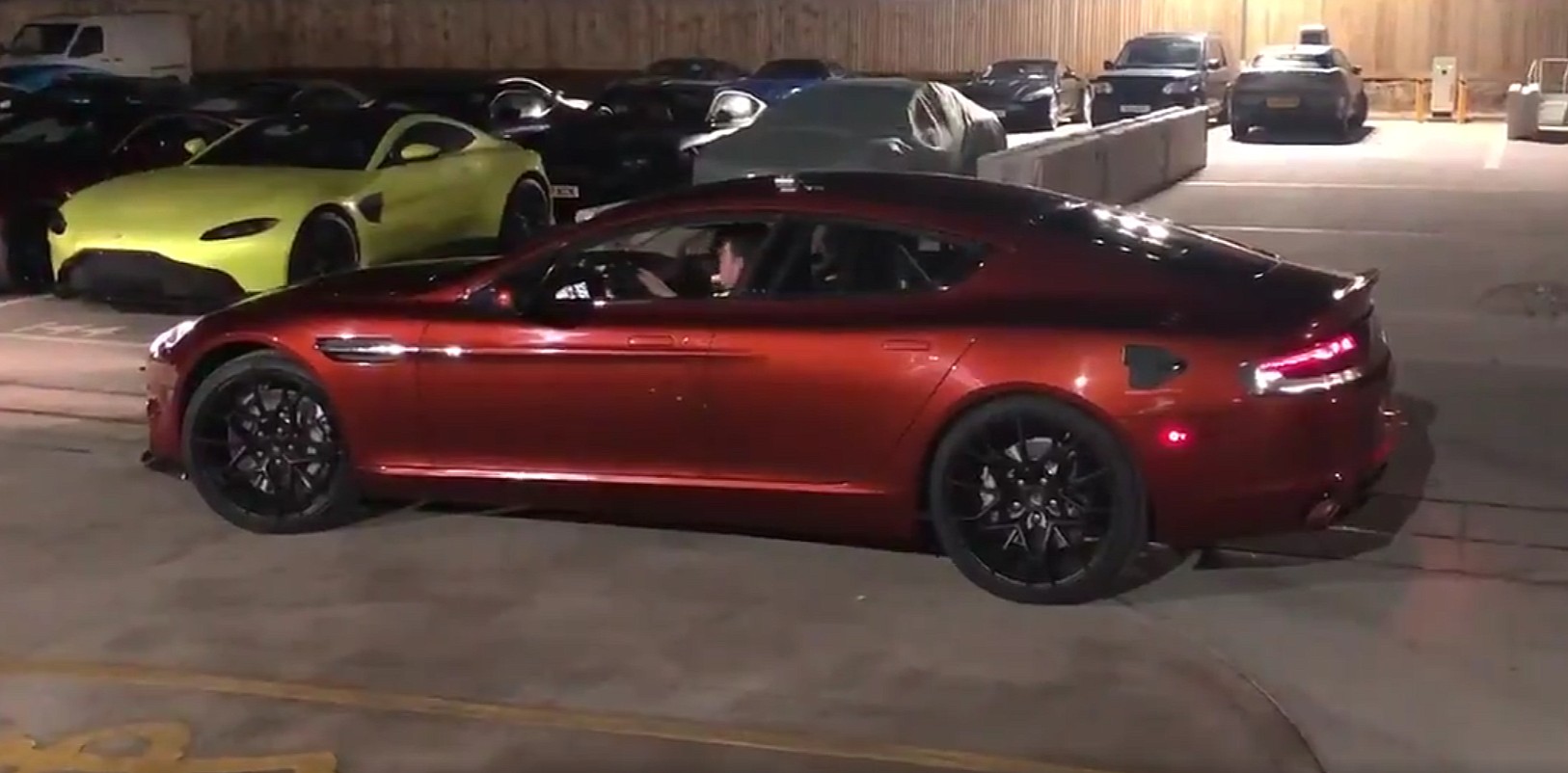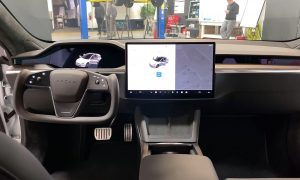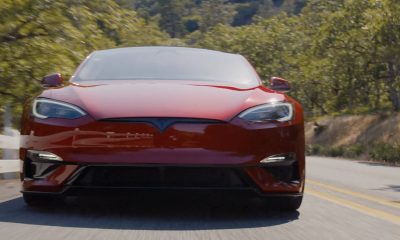

News
Aston Martin’s Rapide E electric car with 800V battery takes first steps in teaser video
With companies like Tesla proving that there is a very real demand for premium, high-performance electric cars, the auto industry’s veteran players are starting to embrace the EV transition. In the case of luxury automaker Aston Martin, the company has opted to start its all-electric push with a limited production run of its high-performance, Porsche Taycan-rivaling Rapide E.
Aston Martin President and Group Chief Executive Officer Andy Palmer recently took to Twitter to share a milestone in the Rapide E’s development. Palmer’s Twitter post featured a short video of a first validation prototype moving on its own for the first time with its 800-volt battery system. The Aston Martin CEO’s video was brief, but the short clip does provide an idea as to how the vehicle looks and sounds like when it’s moving.
Considering that the Rapide E in the video is a first validation prototype, it is quite understandable for the vehicle to move in a very deliberate pace. That said, it is quite interesting to hear what appears to be an audible whine from the car’s electric motors despite the Rapide E’s slow speed. It remains to be seen if the audible sounds from the EV’s motors are deliberate, but it does provide the Rapide E with a rather unique “exhaust note,” electric motors notwithstanding.
A moment of @astonmartin history. First Validation Prototype Aston Martin RapideE moves under its own power for the very first time with its breakthrough 800v battery. Great work from the development team which includes Williams Engineering. pic.twitter.com/b2mRaeCsNP
— Dr. Andy Palmer (@AndyatAuto) January 21, 2019
In the comments section of his post, the Aston Martin executive noted that the Rapide E’s 800-volt battery is a breakthrough in electric car technology, since it gives the vehicle a “significantly quicker fast charging time than any current technology.” Palmer also hinted at “another piece of Aston Martin history” being made on January 21, though the CEO noted that it would remain a “tightly-held secret” for the time being.
In a previous statement to Car and Driver, Palmer noted that the Rapide E would cater to a market that is beyond the premium segment being targeted by companies like Tesla. With a limited production run of 155 vehicles, the Rapide E is targeting customers who desire cars at the top end of the market.
“For me Tesla is a very credible competitor in the premium market, against Daimler, BMW, Audi, and the others. But they’re not in the (upper reaches of the) luxury market where we are. Most of the people who buy a Model S are buying it fully loaded. They’re not limited by their cash; they’re limited by the offer. They’re not a competitor of ours. We’re looking to those people looking for something above Tesla. That customer probably isn’t looking for Ludicrous mode. Our offer will have very credible acceleration, equal to a gasoline Aston Martin, but you’ll be able to drive the car rapidly all the way around the Nürburgring without it derating or conking out on you.”
Overall, it would be quite interesting to see how well the Aston Martin Rapide E stacks up against the competition. With vehicles like the Porsche Taycan Turbo and a possible updated Tesla Model S entering the market in the near future, the luxury carmaker’s flagship car would have to be excellent in all areas to stand out from the competition. In this sense, Aston Martin appears to have done its homework.
To help the company develop the vehicle, the luxury automaker opted to collaborate with Williams Advanced Engineering, the R&D and consultancy arm of the Williams Formula 1 team, to create the Rapide E’s electric powertrain. Aston Martin also noted that it is using an “800V battery electrical architecture with 65kWh installed capacity using over 5600 lithium ion 18650 format cylindrical cells.” The vehicle also packs serious power, with “two rear-mounted electric motors producing a combined target output of just over 610 PS and a colossal 950 Nm of torque.” In a press release last September, Aston Martin noted that the Rapide E would feature a range of over 200 miles per charge under the Worldwide Harmonised Light Vehicle Test Procedure (WLTP).
Production for the Aston Martin Rapide E is expected to begin in Q4 2019. The vehicle’s price has not been announced by the luxury automaker, though speculations suggest that the all-electric car would cost somewhere in the $200,000 to $250,000 range. Reports have hinted that all 155 units of the Rapide E have already been reserved.
Elon Musk
Why Tesla’s Q3 could be one of its biggest quarters in history
Tesla could stand to benefit from the removal of the $7,500 EV tax credit at the end of Q3.

Tesla has gotten off to a slow start in 2025, as the first half of the year has not been one to remember from a delivery perspective.
However, Q3 could end up being one of the best the company has had in history, with the United States potentially being a major contributor to what might reverse a slow start to the year.
Earlier today, the United States’ House of Representatives officially passed President Trump’s “Big Beautiful Bill,” after it made its way through the Senate earlier this week. The bill will head to President Trump, as he looks to sign it before his July 4 deadline.
The Bill will effectively bring closure to the $7,500 EV tax credit, which will end on September 30, 2025. This means, over the next three months in the United States, those who are looking to buy an EV will have their last chance to take advantage of the credit. EVs will then be, for most people, $7,500 more expensive, in essence.
The tax credit is available to any single filer who makes under $150,000 per year, $225,000 a year to a head of household, and $300,000 to couples filing jointly.
Ending the tax credit was expected with the Trump administration, as his policies have leaned significantly toward reliance on fossil fuels, ending what he calls an “EV mandate.” He has used this phrase several times in disagreements with Tesla CEO Elon Musk.
Nevertheless, those who have been on the fence about buying a Tesla, or any EV, for that matter, will have some decisions to make in the next three months. While all companies will stand to benefit from this time crunch, Tesla could be the true winner because of its sheer volume.
If things are done correctly, meaning if Tesla can also offer incentives like 0% APR, special pricing on leasing or financing, or other advantages (like free Red, White, and Blue for a short period of time in celebration of Independence Day), it could see some real volume in sales this quarter.
You can now buy a Tesla in Red, White, and Blue for free until July 14 https://t.co/iAwhaRFOH0
— TESLARATI (@Teslarati) July 3, 2025
Tesla is just a shade under 721,000 deliveries for the year, so it’s on pace for roughly 1.4 million for 2025. This would be a decrease from the 1.8 million cars it delivered in each of the last two years. Traditionally, the second half of the year has produced Tesla’s strongest quarters. Its top three quarters in terms of deliveries are Q4 2024 with 495,570 vehicles, Q4 2023 with 484,507 vehicles, and Q3 2024 with 462,890 vehicles.
Elon Musk
Tesla Full Self-Driving testing continues European expansion: here’s where
Tesla has launched Full Self-Driving testing in a fifth European country ahead of its launch.

Tesla Full Self-Driving is being tested in several countries across Europe as the company prepares to launch its driver assistance suite on the continent.
The company is still working through the regulatory hurdles with the European Union. They are plentiful and difficult to navigate, but Tesla is still making progress as its testing of FSD continues to expand.
Today, it officially began testing in a new country, as more regions open their doors to Tesla. Many owners and potential customers in Europe are awaiting its launch.
On Thursday, Tesla officially confirmed that Full Self-Driving testing is underway in Spain, as the company shared an extensive video of a trip through the streets of Madrid:
Como pez en el agua …
FSD Supervised testing in Madrid, Spain
Pending regulatory approval pic.twitter.com/txTgoWseuA
— Tesla Europe & Middle East (@teslaeurope) July 3, 2025
The launch of Full Self-Driving testing in Spain marks the fifth country in which Tesla has started assessing the suite’s performance in the European market.
Across the past several months, Tesla has been expanding the scope of countries where Full Self-Driving is being tested. It has already made it to Italy, France, the Netherlands, and Germany previously.
Tesla has already filed applications to have Full Self-Driving (Supervised) launched across the European Union, but CEO Elon Musk has indicated that this particular step has been the delay in the official launch of the suite thus far.
In mid-June, Musk revealed the frustrations Tesla has felt during its efforts to launch its Full Self-Driving (Supervised) suite in Europe, stating that the holdup can be attributed to authorities in various countries, as well as the EU as a whole:
Tesla Full Self-Driving’s European launch frustrations revealed by Elon Musk
“Waiting for Dutch authorities and then the EU to approve. Very frustrating and hurts the safety of people in Europe, as driving with advanced Autopilot on results in four times fewer injuries! Please ask your governing authorities to accelerate making Tesla safer in Europe.”
Waiting for Dutch authorities and then the EU to approve.
Very frustrating and hurts the safety of people in Europe, as driving with advanced Autopilot on results in four times fewer injuries!
Please ask your governing authorities to accelerate making Tesla safer in Europe. https://t.co/QIYCXhhaQp
— Elon Musk (@elonmusk) June 11, 2025
Tesla said last year that it planned to launch Full Self-Driving in Europe in 2025.
Elon Musk
xAI’s Memphis data center receives air permit despite community criticism
xAI welcomed the development in a post on its official xAI Memphis account on X.

Elon Musk’s artificial intelligence startup xAI has secured an air permit from Memphis health officials for its data center project, despite critics’ opposition and pending legal action. The Shelby County Health Department approved the permit this week, allowing xAI to operate 15 mobile gas turbines at its facility.
Air permit granted
The air permit comes after months of protests from Memphis residents and environmental justice advocates, who alleged that xAI violated the Clean Air Act by operating gas turbines without prior approval, as per a report from WIRED.
The Southern Environmental Law Center (SELC) and the NAACP has claimed that xAI installed dozens of gas turbines at its new data campus without acquiring the mandatory Prevention of Significant Deterioration (PSD) permit required for large-scale emission sources.
Local officials previously stated the turbines were considered “temporary” and thus not subject to stricter permitting. xAI applied for an air permit in January 2025, and in June, Memphis Mayor Paul Young acknowledged that the company was operating 21 turbines. SELC, however, has claimed that aerial footage shows the number may be as high as 35.
Critics are not giving up
Civil rights groups have stated that they intend to move forward with legal action. “xAI’s decision to install and operate dozens of polluting gas turbines without any permits or public oversight is a clear violation of the Clean Air Act,” said Patrick Anderson, senior attorney at SELC.
“Over the last year, these turbines have pumped out pollution that threatens the health of Memphis families. This notice paves the way for a lawsuit that can hold xAI accountable for its unlawful refusal to get permits for its gas turbines,” he added.
Sharon Wilson, a certified optical gas imaging thermographer, also described the emissions cloud in Memphis as notable. “I expected to see the typical power plant type of pollution that I see. What I saw was way worse than what I expected,” she said.
-

 Elon Musk3 days ago
Elon Musk3 days agoTesla investors will be shocked by Jim Cramer’s latest assessment
-

 News1 week ago
News1 week agoTesla Robotaxi’s biggest challenge seems to be this one thing
-

 News2 weeks ago
News2 weeks agoTexas lawmakers urge Tesla to delay Austin robotaxi launch to September
-

 Elon Musk2 weeks ago
Elon Musk2 weeks agoFirst Look at Tesla’s Robotaxi App: features, design, and more
-

 Elon Musk2 weeks ago
Elon Musk2 weeks agoxAI’s Grok 3 partners with Oracle Cloud for corporate AI innovation
-

 News2 weeks ago
News2 weeks agoSpaceX and Elon Musk share insights on Starship Ship 36’s RUD
-

 News2 weeks ago
News2 weeks agoWatch Tesla’s first driverless public Robotaxi rides in Texas
-

 News2 weeks ago
News2 weeks agoTesla has started rolling out initial round of Robotaxi invites



















